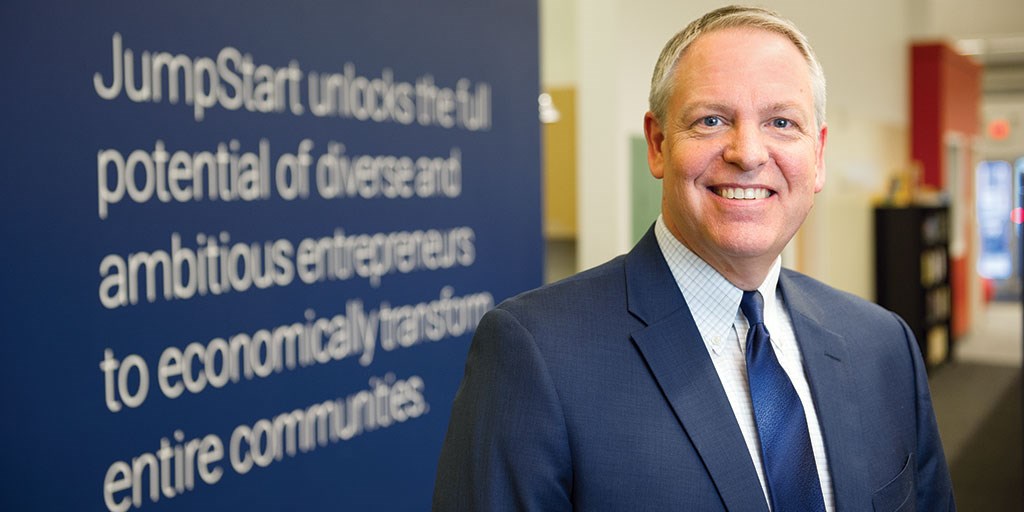Ray Leach is excited about the potential that exists in Cleveland’s entrepreneurial economy to make huge strides in the years ahead. He cautions, however, that nothing is certain.
“The most important thing that needs to happen is the companies we have worked with and invested in generate great exits and returns,” says Leach, founding CEO at JumpStart Inc. “If that happens, the momentum we’ve been able to build will grow.”
JumpStart was formed in 2003 to boost Northeast Ohio’s economic competitiveness by supporting the creation of new companies and new jobs. Leach was brought in to make it all go. Between 2010 and 2016, companies assisted by JumpStart have gone on to generate more than $4.5 billion in cumulative economic impact for the state of Ohio. Dealmaking has been a big piece of the puzzle.
We spoke with Leach for a cover story in our Cleveland magazine, as well as for a Master Dealmakers feature. This week, we share his thoughts about the role M&A plays in building a strong, enduring entrepreneurial economy. What follows is a transcript of the above video, edited for readability.
A 30-year challenge
What is so interesting doing the work at JumpStart and being part of recreating an entrepreneurial economy in Ohio — both a startup and a small business entrepreneurial economy — is every one of these businesses we’re working with is really fragile. In JumpStart’s case, we’re dealing with 1,200 businesses a year that we’re interacting with in some way across the state. Just as a business can be fragile and they need particular resources at the right time and at the right amount to make a difference, when you collect all those businesses, the good news is, in the case of JumpStart, we have a lot of businesses that we’re helping. Because there is some volume, the fragility isn’t an extreme threat.
But when you look at the aggregate economy in the entrepreneurial world, the most significant hurdles we have as a region are around access to capital and around serial entrepreneurs who are coming back and starting new businesses. Most entrepreneurs in Ohio, particularly in the technology business, are doing it for the first time. They are literally leading the first company they have ever led. We have a whole range of entrepreneurs who are really excited about it who have done that, who have had great success and are now getting ready to do it again.
But I think of the transformation of Cleveland and Ohio’s entrepreneurial economy as kind of a 30-year challenge. We’re about halfway through that effort. The most important thing that needs to happen is the companies we have worked with and invested in generate great exits and returns. If that happens, the momentum we’ve been able to build will grow. It’s very encouraging whether it’s CoverMyMeds or the acquisition of Wireless Environment by Ring. Every quarter now, there is a significant exit. Those exits have come from the labors of the last 10-plus years. We’re excited that the momentum we’ve generated is generating positive entropy. Hopefully the economy will stay vibrant, because that is really generating a lot of these exits. If we were to have a downturn, that would bring significant challenges to younger businesses. It’s not like this is a going concern or these are going concerns that are struggling from a profitability point of view. Many of these companies are not profitable, yet. They are growing, but they are early stage. They are figuring things out. JumpStart is trying to keep our fingers on the pulse of lots and lots of companies who have lots of needs and we're encouraged about the future. But the future isn’t certain.
Comparable exits are an important piece
A lot of our companies start almost as projects. They’re really young, really small. And of course when you’re in a scenario where you’re raising larger amounts of capital whether it’s $10 million, $20 million or $30 million — in the venture world, those plans become more significant, 30-, 40-, 50-page plans. But at the stage we’re very focused on, big markets, it’s why an investor could or should believe that it is a big market that deserves a level of investment that is being considered. What are the comparable exits of like companies that the entrepreneur aspires to build? That’s also an important component of the early plan. But the most important piece is the use of funds and how it correlates to a material increase in valuation for the follow-on investors.
Have a vision, have a plan
If you want to be great at investing — one of the things we’ve been great at at JumpStart is building the team of folks that engage and evaluate early-stage deals. Ultimately we as a group make a collective decision along with our board. We have an incredibly capable team that literally looks at hundreds of deals and has a proven track record of figuring out every one of these companies. None of them have revenue. They all have a vision, they all have a plan. JumpStart has been really blessed by having an incredible internal team that’s been able to allow us to identify these great opportunities.
Investing is a team effort. It’s a collective enterprise. I might have particular insights around attributes of an entrepreneur or a particular market. But the collective of our team has really been a principal reason why we’ve had the level of investing success that we have.




